Konica Autoreflex
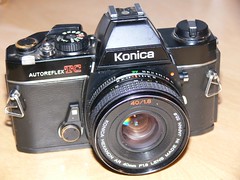
|
| Autoreflex TC. image by Simon Harrison (Image rights) |
Auto-Reflex and Autoreflex are a series of 35mm SLR cameras made by Konica from 1965.
With the introduction of the series Konishiroku changed the lens mount of all their cameras in order to better accomodate the linkage needed to operate the lens aperture. Officially, the new mount was called Konica Bayonet Mount II, but it is more commonly called AR bayonet or K/AR mount, and all the cameras discussed in this section utilize this mount.
An adapter was available to allow the early mount Konica lenses (officially Konica Bayonet Mount, to fit the Konica F, FS, FP, and FM) to be used on these cameras too, albeit with somewhat limited functionality.
K/AR mount lenses use an unusually short film register or flange focal distance (40.5mm). This makes Konica SLR cameras (in both the early and K/AR mount) able to use many other manufacturers' lenses easily, through a series of adapters. For example, vintage Nikon F-mount and Pentax 42mm screw mount lenses can be used on Konica cameras, with some limitations. Konishiroku and others offered simple to use adapters for this purpose. Adapted lenses are able to focus to infinity without additional optics in the adapter.
The reverse is not true, however. Unfortunately, because of their short register distance Konica Hexanon lenses in K/AR mount are not easily adapted for use on most other manufacturers' cameras. They cannot focus to infinity without added, expensive optics, so no adapters exist. It was simply impractical to produce them.
However, adapters do allow use of vintage Konica AR lenses on modern digital camera mounts, including those of Micro 4/3 (four-thirds), APS-C, and full-frame digital cameras.</ref> Adapted lenses will usually be focused manually only, although special adapters are available for some digital cameras that allow autofocus. Also, aperture control will be either fully manual or aperture priority; in the latter case the desired aperture is set on the lens ring, and the camera's built-in meter sets the required shutter speed.
Contents
- 1 Konica Auto-Reflex, Autorex and Revue Auto-Reflex
- 2 Konica Auto-Reflex P, Autorex P and Revue SP
- 3 Autoreflex T, FT A and Revue TTL
- 4 Autoreflex A
- 5 Autoreflex T"2" and "New" FT A
- 6 Autoreflex A"2"
- 7 Autoreflex A1000
- 8 Autoreflex T3 and T3N
- 9 Autoreflex A3
- 10 Autoreflex TC and Acom-1
- 11 Autoreflex T4
- 12 References
- 13 Links
Konica Auto-Reflex, Autorex and Revue Auto-Reflex
| ||
| ||
|
The Konica Auto-Reflex of 1965 was the world's first auto-exposure 35mm focal-plane-shutter SLR; hence the name. This new technology made it "the star" of the International Photography Fair in New York where it was shown, according to one magazine.[1]
This model and its rarer, meterless companion the Konica Auto-Reflex P are the only models with "Auto-Reflex" as separate hyphenated words. These are also the only two SLRs that ever offered a choice of full- or half-frame exposures, switched by a lever on top of the camera. The frame size can be changed between 24×36 landscape and 18×24 portrait in mid-roll.
Autorex is the name for the domestic Japanese market. In Germany the camera was also sold as Revue Auto-Reflex.
For the Auto-Reflex, the meter sensor is mounted on the front, right-hand side of the camera. This is not TTL metering, although it does offer a shutter-preferred, auto-exposure mode. TTL auto exposure was also pioneered in a Konica a few years later, with the Autoreflex T (FTA in Japan).
It has the new Konica Bayonet II mount, which is also often called K/AR mount. PX675 type mercury batteries are only needed for the light meter. Shutter speeds run from 1s to 1/1000s and B.
See also: 47-100mm f3.5 Hexanon AR-H lens.
All versions of this model were available in both matte chrome and all-black finishes. All-black cameras are considerably rarer and tend to be more valuable.
Lenses offered with the Auto-Reflex/Autorex are a bit unusual, too. They originally did not have a registration notch on the rear, which was needed with latter TTL metered models but was unnecessary on this model. The notch tells the camera the lens' maximum aperture. At the time the later models were introduced, many Auto-Reflex/FTA lenses were sent in for a service upgrade to modify them for use with the TTL models. For a period of time, factory service facilities performed this service for free. The result is that un-modified original Auto-Reflex/Autorex lenses are somewhat unusual today.
Also, normal lenses sold with the Revue version of this camera were often unlabelled, fitted with a plain finish ring that did not have the Hexanon name on it.
Konishiroku apparently did not rebrand any of their K/AR mount SLR models for sale through Montgomery Ward in the United States, as they had with the FP in the earlier mount. They did continue to market a number of rebadged rangefinder cameras through Wards, however (EEMatic and Auto S models, for example).
Konica Auto-Reflex P, Autorex P and Revue SP

|
| Auto-Reflex P with Hexanon 52mm f1.8 lens image by Alan Myers (Image rights) |
The Konica Auto-Reflex P released in 1966 is a stripped-down Auto-Reflex without light meter and therefore without auto-exposure, allowing it to be offered as a lower priced alternative. In Japan it was sold as Autorex P, in Germany as the Revue SP, marketed by Foto Quelle (there was not a Wards rebranding of this model).
It is fully mechanical and therefore does not utilize batteries. The shutter speeds are controlled by a knob that replaced the meter sensor on the right front of the camera. Speeds are the same: 1s to 1/1000s and B, and up to 1/125 electronic flash sync.
As with the Auto-Reflex, the frame size can be switched between 24×36mm landscape and 18×24mm portrait, even mid-roll. (Note: With either of the dual-format Konica cameras, mid-roll size changes make film processing labs crazy! Be sure to alert your processor whenever this is done, or they might damage images when the film is cut into shorter strips)
There is a special accessory light meter offered for use with the P models.
It is believed all versions of these models were only offered in matte chrome finish.
It seems to have sold in far less quantity than the model with the built-in light meter, so the Auto-Reflex P is much rarer today and often sells at a higher price, even though it was the cheaper model when new.
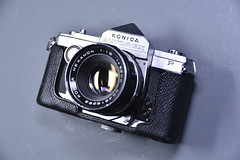
|
| Japanese Autorex P image by nik.jalopx (Image rights) |
Autoreflex T, FT A and Revue TTL
The Autoreflex T of 1968 was the first focal plane shutter 35mm SLR with auto-exposure and TTL metering combined in one body. In Japan it was sold as FT A, in Germany as Revue Autoreflex TTL. From this model on, the name "Autoreflex" is not hyphenated as it was on the previous models.
It is fully mechanical with shutter-priority auto exposure. The batteries (two PX 675 type mercury cells) are only needed for the CdS light meter. The shutter speed range is from 1s to 1/1000s and B.
A special version of this model, known as the Autoreflex W, has a timing back, for use at sporting events. It imprints the time of the exposure on each frame of film. The back is similar in function to the one offered in 1963 on the Konica FS-W, an early Konica bayonet mount camera.
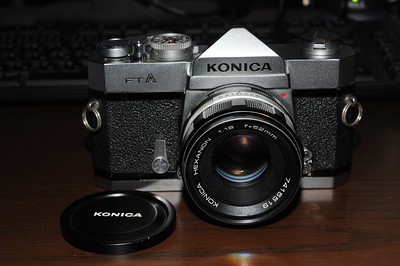
|
| FT A (original model) image by Akira Nakajima (Image rights) |
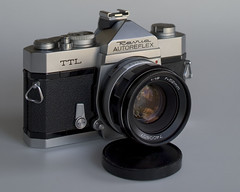
|
| Revue Autoreflex TTL image by Alan Myers (Image rights) |
Autoreflex A
The Autoreflex A is a stripped-down Autoreflex T without self-timer, mirror lock-up, depth-of-field preview, on/off-switch, and battery control, and with 1/500s top shutter speed.
Autoreflex T"2" and "New" FT A
The Autoreflex "T2" is an improved Autoreflex T. The model name on the body still says "Autoreflex T". In Japan it was known as "New" FT A, but is still only labelled "FT A". Both the versions of T and FT A were hugely successful and are still widely found today. These models might be considered the SLRs that truly established Konica's reputation for quality. Many of both versions continue to function well 35 or more years after they were manufactured.
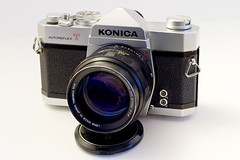
|
| Autoreflex "T2" image by Bryan Costin (Image rights) |
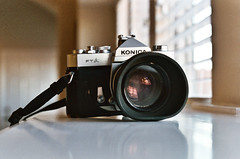
|
| "New" FT A image by Erik Beyer (Image rights) |
The most recognizable differences between the T"1" and T"2" (and FT A and "New" FT A)is that the latter has the on/off switch as a small collar that rotates around the shutter release button. On the earlier camera, the switch was located on the back, lefthand side. Also omitted from the later camera is a small lever under the shutter speed dial labeled "Override" on the earlier camera. This change shows the improved range of the meter sensitivity, and the override capability was no longer considered necessary.
The T"2"/"New" FT A also saw a number of small, internal changes in the materials used and methods of assembly. This was largerly to make the camera more easily serviced. For example, where some brass screws were used originally, these were replaced with stronger steel screws that were less inclined to strip or snap off when being removed.
Although the names T"2" or "New" FT A never actually appeared on the outside of the camera, there were references to the model designation in Konishiroku memos and literature at the time. Service bulletins, for example, distinguished the later cameras from the earlier by reference to these model designations. Also, note that the next model offered was known as the Autoreflex T3.
One small flaw found in Autoreflex T is the battery compartment. It appears the wrong type of flux was used when soldering the wire connections. This makes the wire and solder more vulnerable to any battery leakage, more prone to corrosion. The fix is simple, though. Perhaps 9 out of 10 times an Autoreflex T with a non-responsive meter can be easily repaired with a little cleaning and, perhaps, re-soldered connection or two near the battery compartment.
Both the Autoreflex T"2" and "New" FT A can be found in both matte chrome and all black finishes. The black versions are rarer and more valuable.
There was also an optional split image focus assist screen available on a few of this model. Up to now, the Konica K/AR cameras all had matte focus screens with a micro-diaprism dot in the center to help with focus. The split focus assist feature is not interchangeable by the user (the way some other camera's focus screens are), and is pretty rare. (Note: In the earlier F/FS mount, Konica has similar screens with matte field and a central micro-diaprism dot, except for the highly valued and rare Konica F which not only has an interchangeable pentaprism, but also has the split image focus assist feature.)
It does not appear that marketing of rebranded cameras was continued with this or subsequent models, either under the Revue (Foto-Quelle) name in Europe, or the Wards (Montgomery Wards) name in the US. In fact, no K/AR or Konica Bayonet Mount II SLR models appear to have been marketed under the Wards name. Only the Auto-Reflex, Auto-Reflex P and original T/FTA appear to have been rebranded with the Revue name and marketed via Foto-Quelle.
Autoreflex A"2"
The Autoreflex A"2" is an improved Autoreflex A or stripped-down Autoreflex T"2" without self-timer, mirror lock-up, depth-of-field preview, on/off-switch, and battery control, and with 1/500s top shutter speed. The engraved model name on the camera still reads "Autoreflex A", but it apppears to have received the same internal improvements as the T"2" or "New" FTA.
Autoreflex A1000
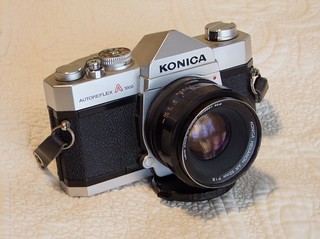
|
| Autoreflex A1000 image by Peter Davies (Image rights) |
The Autoreflex A1000 is an improved Autoreflex A2 or stripped-down Autoreflex T2, with a top shutter speed of 1/1000s, but without self-timer, on/off switch, depth-of-field preview, or mirror lock-up. It was sold only in North America.
Autoreflex T3 and T3N

|
| Autoreflex T3. image by Diego Cantalapiedra (Image rights) |
The Autoreflex T3 from 1973 is a completely redesigned and improved Autoreflex T"2", now providing stop-down (depth-of-field) preview, double-exposure possibility as well as a wider range of film speed (ISO 12–3200). Both the meter scale (apertures) and shutter speed setting are visible in the viewfinder, which has improved brightness compared to earlier models.
The Autoreflex T3"N" or "New" is an improved version of the T3 released a year later with a fixed hot shoe and a viewfinder shutter, while the earlier T3 has a detachable accessory shoe. The model name on the body still says "Autoreflex T3", though the model designation of T3"N" or "New" is in common and wide use. From the front, the T3"N" can be recognized by the lower profile of the hot shoe, recessed into the pentaprism housing, and by its black self-timer/DOF preview lever with a distinctive white stripe painted on it. On the earlier model's removable hot shoe stood taller and it's self-timer/DOF preview lever was painted silver on the matte chrome models and solid black on the black finished T3 model. From the rear, the little lever that operates the viewfinder shutter is obvious, just to the left of the eyeport of the viewfinder. "CL." and an arrow showing the direction to move the lever to close the shutter is adjacent to the little lever. From the top, the T3 is labelled "T-3" beside the film rewind knob. On the T3"N", the camera's serial number is found imprinted there.

|
| Autoreflex T3"N". image by Enea Pestelacci (Image rights) |
If the Autoreflex T/FT A and T"2"/"New" FT A established Konica SLR as a major and important brand, the T3 and T3"N" took this to a higher level. It is a completely redesigned camera with a number of improvements. The T3/T3"N" are described as "buttery smooth" in operation by many fans. It is also the last of the all-metal, full-size Konica. Highly durable, many remain in use today despite having little or no service attention over 30 or more years use.
Both T3 and T3"N" can be found in matte chrome and all black finishes, with the black version being rarer and more valuable.
The optional split image focus assist screen feature was increasingly available. In the final year or two of production, another version of the screen became available that featured the split image dot in the center and a "donut" of micro-diaprisms around that, both of which were in the center of the matte focus screen. Models fitted with the special screen feature had a small silver tag stuck on the back with "S.I." printed on it. The final version of focus screen became the standard on all subsequent Konica models (TC, T4, FT-1, etc.)
Autoreflex A3
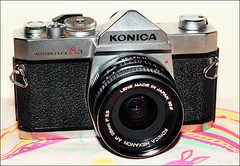
|
| Autoreflex A3 image by John Gateley (Image rights) |
The "Autoreflex A3" is a stripped-down Autoreflex T3 without self-timer, depth-of-field preview, mirror lock-up, multi-exposure provision, on/off switch, battery control, M flash synch, and hot shoe. It replaced the A"2" and A1000 as an entry level model, but now built on a chassis shared with the T3.
Autoreflex TC and Acom-1
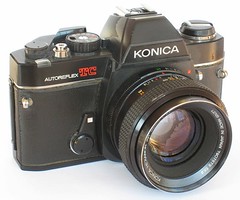
|
| Autoreflex TC. image by Howard Somerville (Image rights) |
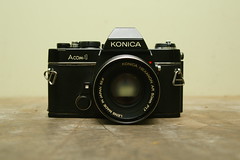
|
| ACOM-1 image by kanonn (Image rights) |
The Autoreflex TC of 1976 was originally offered alongside the T3/T3"N" and replaced the A3 as the entry-level SLR model. It's a scaled down camera, smaller than the previous models, probably following the trend in the photo industry toward more compact SLR cameras and lenses. The shutter speeds run from 1/8 to 1/1000s and B. In Japan it was sold as the Acom-1. The Acom-1 was offered in 1978 with a Date Back option, but the TC never was.
Autoreflex T4

|
| Autoreflex T4 with Auto Winder image by Hans Kerensky (Image rights) |
The Autoreflex T4 looks similar to the simpler Autoreflex TC. Both are smaller than the earlier Autoreflex bodies, use plastic top plate, but retain a metal frame.
The T4 is the top-of-the-line Konica SLR of its day and still a full-featured, fully mechanical SLR with a CdS TTL light meter and shutter-priority auto-exposure. The shutter speed range is 1s to 1/1000s and B, and the batteries (two PX625 mercury cells) are only needed for the light meter.
The T4 was the first Konica SLR for which an accessory film winder was offered. It's capable of advancing the film approx. 2 frames per second, does not have an auto rewind mode.
Both the TC and T4, and the Winder AR for the T4 were fitted with a relatively unusual, soft type of leatherette. (Minolta used similar on a couple models.) It was nice when new, but is pretty easily damaged and over time tends to shrink from the edges and look ugly. It's pretty easily replaced with another type of leatherette or even real leather, which really improves the look and feel of the camera. While largely cosmetic, the leatherette covering does seal the camera against dust and moisture getting into a number of access points and joints between assemblies, as well as providing a good grip for the user.
References
- ↑ "Come to the Photo Fair" by Everett H. Ortner, Popular Science magazine (USA) May 1966; from Google Books
Links
General links
- www.buhla.de: Konica SLR system, with detailed pages about every model in the Auto-Reflex/Autoreflex range, for example
- konicafiles.com (used to be konica.awardspace.com), site devoted to the Konica SLR system
- Autoreflex T4 by Davidde Stella
- Lionel's Konica Autoreflex T overview at 35mm-compact.com (in French)
- Autoreflex A, Autoreflex T, Autoreflex T3, Autoreflex T4, Autoreflex TC on www.collection-appareils.fr by Sylvain Halgand (in French)
- Konica Auto-Reflex, Autoreflex T and Autoreflex T3 at The Camera Site by Reijo Lauro (new domain name noted 1-2022)
- Revue Auto-Reflex at Kurt Tauber's Deutsches Kameramuseum (in German)
- Konica Auto-Reflex PDF manual OrphanCameras.com
- Konica Autoreflex T PDF manual at OrphanCameras.com
- Konica Autoreflex A PDF manual at OrphanCameras.com
- Konica Autoreflex A3 PDF manual at OrphanCameras.com
- Konica Autoreflex TC PDF manual at OrphanCameras.com
- Konica Autoreflex T3 PDF manual at OrphanCameras.com
- Konica Autoreflex T4 PDF manual at OrphanCameras.com


